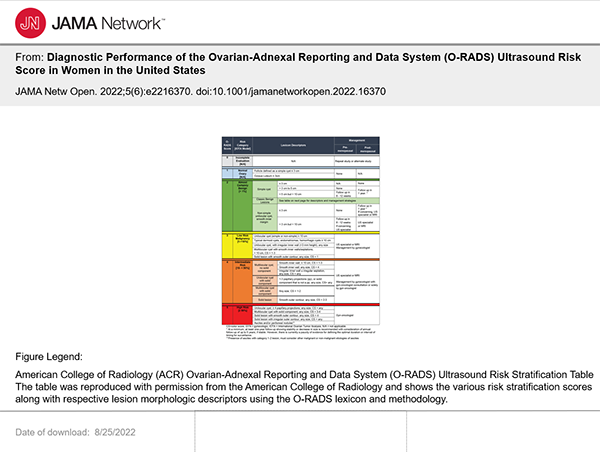Findings Validate O-RADS Ultrasound Risk Scoring System Performance
 Priyanka Jha, MBBS, associate professor of clinical radiology, recently led a team of investigators who studied the diagnostic performance of the Ovarian-Adnexal Reporting and Data System (O-RADS). They found that the ultrasound risk stratification system performed within the expected range specified by the American College of Radiology (ACR).
Priyanka Jha, MBBS, associate professor of clinical radiology, recently led a team of investigators who studied the diagnostic performance of the Ovarian-Adnexal Reporting and Data System (O-RADS). They found that the ultrasound risk stratification system performed within the expected range specified by the American College of Radiology (ACR).
“Our study found that the O-RADS ultrasound (US) score of four was the optimum cutoff for diagnosing ovarian cancer, and the calculated frequency of malignant neoplasm for each of the O-RADS US score fell within the lower end of the expected range,” says Dr. Jha. “This means that our findings validated O-RADS utilization for everyday general practice
Findings were recently published in JAMA Network Open.
In the case of pelvic ultrasounds, when adnexal lesions (growths in or near the ovaries) are found, it’s important to classify them as either benign or potentially malignant. This helps determine appropriate recommended follow up and treatment. Most adnexal lesions are benign and carry low risk for developing into cancer, but those lesions not classified as dermoid, endometriomas, hemorrhagic cysts or simple cysts carry increased risk.
“We hope the findings from our study promote more confident use of both this uniform lexicon and malignancy risk estimation based on morphological evaluation and management strategies which could prevent surgery for benign lesions and expedite referrals to gynecology oncology for malignant lesions,” says Dr. Jha.

Back in 2018, the ACR developed the O-RADS system with the help of a multidisciplinary committee of clinicians and researchers from gynecologic oncology, gynecology, pathology and radiology. Lori Strachowski, MD, clinical professor in the Departments of Radiology and Biomedical Imaging and Obstetrics, Gynecology, and Reproductive Sciences at UC San Francisco, is one of the original members of the ACR O-RADS committee. Dr. Jha is also part of the O-RADS committee and helped author the user’s guide.
The goal of O-RADS is to provide more consistent interpretations, minimize or eliminate ambiguity in US reporting, and provide a risk of malignancy and management recommendation for each type of lesion or risk category. Ultimately, use of the system will result in more accurate diagnoses and optimal patient management.
According to the authors, studies have been conducted on O-RADS’ diagnostic performance in Asia, Europe and the Middle East. Dr. Jha and team wanted to study O-RADS in a non-selected population of women in the U.S. who presented to radiology departments. Their cohort study included a non-selected patient population - 913 patients with 1014 adnexal lesions with an average age of 42.4 years with 673 premenopausal.
The full list of authors include Akshya Gupta, MD and Timothy Baran, PhD (University of Rochester), Katherine Maturen, MD, MS (University of Michigan, Ann Arbor), Krupa Patel-Lippmann, MD (Vanderbilt University Medical Center), Hannah Zafar, MD, MS (University of Pennsylvania), Aya Kamaya, MD and Neha Antil, MD (Stanford University) and Elizabeth Sadowski, MD (University of Wisconsin-Madison).
